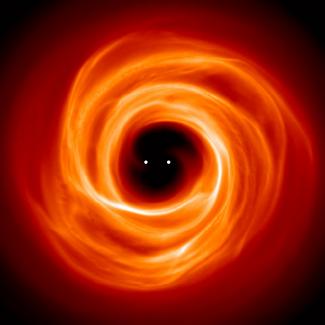Astrophysicists know that the centers of galaxies have supermassive black holes whose size correlates with the size of the galaxy surrounding them. They’ve also observed that galaxies collide and merge. In fact, galactic mergers were even more common billions of years ago in the Universe when today’s galaxies were still being assembled.
So what happens to the original central black holes when galaxies merge? The two black holes end up in the center of the new and larger galaxy, where they either rotate around each other as a binary or merge together. The odds are on mergers because of the size correlation and the fact that the only direct evidence for black hole binaries consists of a single galaxy that appears to have two nuclei about 20–25 light years apart.
In 1980, Fellow Mitch Begelman (then at the University of California at Berkeley) and colleagues from Caltech and the United Kingdom’s Institute of Astronomy solved part of the problem of explaining how black holes merge. They showed that the black holes “bump” into stars, knocking them away from the galaxy centers. In the process, the black holes lose energy and move closer together until the process grinds to a halt when the black holes are about .1–.01 light years apart. At this point, there aren’t any stars left to kick out of the galactic center. Begelman and his colleagues deduced that gas clouds might be involved in the process, but the modeling techniques available in those days weren’t up to the task of analyzing their role.
Fast forward 28 years. Begelman recently joined forces with Fellow Phil Armitage and former research associates Jorge Cuadra and Richard Alexander to use high-speed supercomputers to analyze the role of gas discs in black-hole binary mergers. The researchers wanted to see whether interactions with gas clouds could bring binaries close enough together (.003 light years) for the force of gravity to complete the merger. They also wanted to get an idea about the frequency of such mergers, which, according to Einstein’s relativity theory, will produce gravitational waves. Gravitational waves from binary mergers will be detected and measured by the Laser Interferometer Space Antenna (LISA) observatory, scheduled for launch in 2020. LISA has been Fellow Pete Bender’s pet project for more than two decades (see JILA Light & Matter, Summer 2006).
Bender got some encouraging news from the results of Begelman and Armitage’s study. In Begelman and Armitage’s simulations, the interaction of gas discs with black-hole binaries caused the orbits of the black holes to shrink and their orbital eccentricity to increase. The more gas that was available, the faster the process occurred. If the mass of the simulated black holes was less than 10 million Suns, the holes could merge! The good news is that LISA is most sensitive to such low-mass mergers and should be able to detect mergers promoted via a binary’s interaction with a gas disc. The bad news is that the new mechanism can’t explain the supermassive black holes at the hearts of large elliptical galaxies. The new mechanism simply didn’t work for black holes more massive than 10 million Suns. In that case, the simulation required so much gas to cause a merger that the gas disc fragmented into stars. This result left two interesting possibilities: (1) A third process must be involved in coalescence of more massive black holes. One possible mechanism would be a binary’s interaction with new stars formed when a large gas disc fragments. Or, (2) there might be a lot of black-hole binaries in the Universe in such close orbits that they can’t be resolved by observations. This option creates a couple of major problems.
First, space-based observatories should be able to detect binary quasars if permanent black-hole binaries occur routinely. Second, the formation of permanent black-hole binaries can't possibly have been in play in the early Universe when mergers were common. Otherwise, when merged galaxies merged with each other, 3–4 black holes might end up knocking each other around in the center of the new galaxy. At least occasionally all of the black holes would be ejected, leaving a galaxy without a black hole at its center. No such galaxies are known.
The most sensible conclusion is that there’s still more to learn about the process of merging two massive black holes. - Julie Phillips




